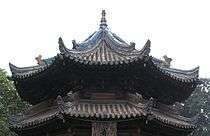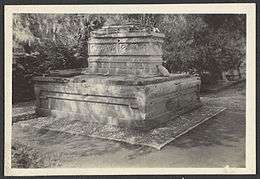Ma Anliang
Ma Anliang (simplified Chinese: 马安良; traditional Chinese: 馬安良; pinyin: Mǎ Ānliáng; Wade–Giles: Ma An-liang, French romanization: Ma-ngan-leang,[2] Xiao'erjing: ﻣَﺎ ءًا ﻟِﯿْﺎ; 1855 – November 24, 1918) was a Hui born in Hezhou, Gansu, China. He became a general in the Qing dynasty army, and of the Republic of China. His father was Ma Zhan'ao, and his younger brothers were Ma Guoliang[3] and Ma Suiliang (Ma Sui-liang) 馬遂良.[4] Ma was educated in Chinese and Islamic education.[5] His Muslim name was Abdul Majid 阿卜都里默直底.
| Part of a series on Islam in China | ||||||
|---|---|---|---|---|---|---|
 | ||||||
|
||||||
|
| ||||||
Ma Anliang | |
|---|---|
 Pailou arch set up in honor of Ma Anliang | |
| Born | 1855 Hezhou, Gansu |
| Died | November 24, 1918 (aged 62–63) Hezhou, Gansu |
| Allegiance | |
| Years of service | 1872-1918 |
| Rank | General |
| Commands held | General of Xinjiang, Colonel of Hezhou |
| Battles/wars | Dungan revolt (1862–77), Dungan revolt (1895–96), Boxer Rebellion, Xinhai Revolution, Bai Lang Rebellion |
| Awards | "Second class Wenhu and Chiaho decorations"[1] |
Military career
He defected to Qing in 1872 during the Dungan revolt (1862–77), along with several other Hui Muslims, including his father, Ma Zhan'ao, Ma Haiyan, and Ma Qianling. They belonged to the Huasi menhuan, of the Khafiya Naqshbandi Sufi order.[6] They assisted the Qing Han Chinese general Zuo Zongtang in suppressing the Muslim revolt. In 1877, his father Ma Zhanao defeated a group of Muslim rebels who continued fighting near Hezhou.[7]
General Ma Anliang joined the Qing General Zuo Zongtang, in the campaign against the Turkic Muslim rebels under Yaqub Beg. Ma Anliang led an entire army composed of Chinese Muslim troops against Yaqub Beg's Turkic Muslim forces, and defeated him, reconquering Turkestan for China.[8]
Dong Fuxiang, Ma Anliang and Ma Haiyan were originally called to Beijing during the First Sino-Japanese War in 1894, but the Dungan Revolt (1895) broke out and they were subsequently sent to crush the rebels.[9]
In 1895, he served with the Han Chinese general Tang Yanhe and the Muslim general Dong Fuxiang, assisting them in crushing another Muslim revolt, the Dungan revolt (1895–96).[10][11] His Muslim cavalry defeated Muslim rebels at Oxheart Mountain, and relieved the siege of Hezhou on December 4. He led Hui cavalry troops to slaughter rebel Salar Muslim fighters who had agreed to negotiate unarmed at a banquet by telling them "Disown me as a Muslim if I deceive you.", and received the rank of Xinjiang General, and Hezhou Colonel once the revolt was crushed.[12] The revolt was led by Ma Yonglin, Ma Wanfu, and Ma Dahan. Ma Dahan was publicly executed.[13] It was said that Muslim blood stained red red cap of Ma Anliang.[14]
During that war, in 1895 Ma lifted the siege of Xining (sining) with four ying (ying is a Chinese unit for battalion). Ma was assigned to "Barkul military command" sometime before 1910.[15][16]
During the Hundred Days' Reform in 1898 Dong Fuxiang, Ma Anliang, and Ma Haiyan were called to Beijing and helped put an end to the reform movement along with Ma Fulu and Ma Fuxiang.[17]
In 1900, during the Boxer Rebellion, Ma Anliang, as Tongling of Ho-Chou joined Dong Fuxiang in fighting against the foreigners.[18]
In 1905, Ma Anliang, in cooperation with the Han Chinese magistrate Yang Zengxin, attempted to arrest and execute the Yihewani (Ikhwan in Arabic) leader Ma Wanfu. Ma Qi, one of Ma Anliang's subordinates, staged a rescue operation and brought Ma Wanfu to Xining.[19]
Even though he was a Muslim, he and his Muslim troops showed no mercy to Muslims who rebelled against the Qing government, and massacred them.
In 1911, when the Xinhai Revolution erupted, he led over 20 battalions of Hui Muslim troops to defend the Qing dynasty by attacking Shaanxi, which was held by the revolutionaries under Zhang Fenghui. He defeated the revolutionaries in combat, but then when the Qing emperor Puyi abdicated, Ma agreed to join the new Republic of China government under the Kuomintang.[20]
In October 1903, in Ili, Ma Anliang served as "Brigade-General". In April 1912 he became "Commander-in-Chief" of Gansu.[21]
Political and religious orientation
Ma Anliang fought against the Bai Lang Rebellion, and attacked the Xidaotang (西道堂) Muslim organization. He was suspicious of the Republicanism of the Xidaotang, since Ma was a conservative and a monarchist and supported Yuan Shikai. Ma arranged for the Xidaotang founder Ma Qixi and his family to be shot dead. Han and Hui soldiers under the Hui generals Ma Anliang and Ma Qi united to fight against Bai Lang's bandit army.[22] [23][24]
In 1914, Ma Anliang tried to exterminate the "New New Sect", the Xidaotang and its leader Ma Qixi (his Arabic name was Ersa (Jesus), he was known as "Prophet Jesus" to westerners).[25][26]
General Ma Anliang was the de facto senior leader of all Muslims in northwestern China from the beginning of the Republican era in 1912 until he died. He was succeeding by General Ma Fuxiang in this position.[27]
Ma Anliang was considered "reactionary", while the learned "scholar" General Ma Fuxiang was considered "progressive".[28]
In 1917 Ma Anliang ordered his younger brother Ma Guoliang to suppress a rebellion of Tibetans in Xunhua who rebelled because of taxes Ma Anliang imposed on them. Ma Anliang did not report it to the central government in Beijing and was reprimanded for it, and Ma Qi was sent by the government to investigate the case and suppress the rebellion.[29]
He died in Hezhou (Hochow) on November 24, 1918.[30][31] After his death, Ma Anliang was praised by American Vice-Consul at Kalgan, Rodney Gilbert in the Herald for keeping peace in Gansu, which he maintained by his willingness to fight against his fellow Muslims.[32] Ma Anliang was also praised for protecting "his people from sectarian strife and opium".[33]
Ma Fuxiang effectively took Ma Anliang's place as de facto leader of Muslims in northwest China when Ma Anliang died in 1918.[34][35]

Family
His father was Ma Zhan'ao and his brother was Ma Guoliang.
He had 5 sons, Ma Tingxiang (Ma T'ing-hsiang) (馬廷勷) (3rd son), Ma Tingxian (Ma T'ing-hsien) (馬廷賢) (4th son),[36] and 3 other unknown children. Ma Tingxian was executed in 1962 by the Peoples' Court.[37] Ma Tingxiang was Ma Anliang's third son. He was executed by Feng Yuxiang after first rebelling against Feng and the Guominjun, defecting to Chiang Kaishek and the Kuomintang after Chiang and Feng went to war against each other, and finally after Chiang dismissed Ma from his posts, attempted to flee and was captured by Feng.
Peerage
Yuan Shikai made Ma Anliang a Baron of the First Rank (一等男; Yī děng nán) of the Empire of China (1915–16).
See also
References
- Henry George Wandesforde Woodhead, Henry Thurburn Montague Bell (1969). The China year book, Part 2. North China Daily News & Herald. p. 841. Retrieved 2011-06-05.
- Heylen, Ann (2004). Chronique Du Toumet-Ortos: Looking Through the Lens of Joseph Van Oost, Missionary in Inner Mongolia (1915-1921). Volume 16 of Louvain Chinese studies (illustrated ed.). Leuven University Press. p. 373. ISBN 9058674185. Retrieved 24 April 2014.CS1 maint: ref=harv (link)
- Jonathan Neaman Lipman (2004). Familiar strangers: a history of Muslims in Northwest China. Seattle: University of Washington Press. p. 168. ISBN 0-295-97644-6. Retrieved 2010-06-28.
- 甘、寧、青三馬家族世系簡表
- Jonathan Neaman Lipman (2004). Familiar strangers: a history of Muslims in Northwest China. Seattle: University of Washington Press. p. 206. ISBN 0-295-97644-6. Retrieved 2010-06-28.
- Michael Dillon (1999). China's Muslim Hui community: migration, settlement and sects. Richmond: Curzon Press. p. 140. ISBN 0-7007-1026-4. Retrieved 2010-06-28.
- Jonathan Neaman Lipman (2004). Familiar strangers: a history of Muslims in Northwest China. Seattle: University of Washington Press. p. 167. ISBN 0-295-97644-6. Retrieved 2010-06-28.
- Lanny B. Fields (1978). Tso Tsung-tʼang and the Muslims: statecraft in northwest China, 1868-1880. Limestone Press. p. 81. ISBN 0-919642-85-3. Retrieved 2010-06-28.
- "董福祥与西北马家军阀的的故事 - 360Doc个人图书馆". Archived from the original on 2018-12-14. Retrieved 2014-10-30.
- Michael Dillon (1999). China's Muslim Hui community: migration, settlement and sects. Richmond: Curzon Press. p. 136.
- Jonathan Neaman Lipman (2004). Familiar strangers: a history of Muslims in Northwest China. Seattle: University of Washington Press. p. 168. ISBN 0-295-97644-6. Retrieved 2010-06-28.
- Michael Dillon (1999). China's Muslim Hui Community: Migration, Settlement and Sects. Psychology Press. pp. 72–. ISBN 978-0-7007-1026-3.
- Papers from the Conference on Chinese Local Elites and Patterns of Dominance, Banff, August 20–24, 1987, Volume 3 Papers from the Conference on Chinese Local Elites and Patterns of Dominance, Banff, August 20–24, 1987, Joint Committee on Chinese Studies (U.S.). Ann Arbor. 1987. p. 29.
- Ma Tong, Zhongguo Yisilan... shilue, p 245
- University of Illinois at Urbana-Champaign. Center for Asian Studies (1979). Chinese Republican studies newsletter, Volumes 5-7. p. 35. Retrieved 2011-06-06.
- Chinese Republican Studies Newsletter. 1–8. Center for Asian Studies, University of Illinois. 1975. p. 171. Retrieved 24 April 2014.CS1 maint: ref=harv (link)
- "董福祥与西北马家军阀的的故事 - 360Doc个人图书馆". Archived from the original on 2018-12-14. Retrieved 2014-10-30.
- M. Th. Houtsma, A. J. Wensinck (1993). E.J. Brill's first encyclopaedia of Islam 1913-1936. Stanford BRILL. p. 850. ISBN 90-04-09796-1. Retrieved 2010-06-28.
- Jonathan Neaman Lipman (2004). Familiar strangers: a history of Muslims in Northwest China. Seattle: University of Washington Press. p. 207. ISBN 0-295-97644-6. Retrieved 2010-06-28.
- Jonathan Neaman Lipman (2004). Familiar strangers: a history of Muslims in Northwest China. Seattle: University of Washington Press. p. 170. ISBN 0-295-97644-6. Retrieved 2010-06-28.
- Henry George Wandesforde Woodhead, Henry Thurburn Montague Bell (1969). The China year book, Part 2. North China Daily News & Herald. p. 841. Retrieved 2011-06-05.
- Jonathan Neaman Lipman (2004). Familiar strangers: a history of Muslims in Northwest China. Seattle: University of Washington Press. pp. 191, 194. ISBN 0-295-97644-6. Retrieved 2010-06-28.
- Michael Dillon (1999). China's Muslim Hui community: migration, settlement and sects. Richmond: Curzon Press. p. 144. ISBN 0-7007-1026-4. Retrieved 2010-06-28.
- Dru C. Gladney (1996). Muslim Chinese: ethnic nationalism in the People's Republic. Cambridge Massachusetts: Harvard Univ Asia Center. p. 58. ISBN 0-674-59497-5. Retrieved 2010-06-28.
- Samuel Marinus Zwemer, ed. (1920). The Moslem World. 10. New York: Christian Literature Society for India, Hartford Seminary Foundation. p. 381. Retrieved 2011-06-06.
- The Far Eastern review, engineering, finance, commerce. 15. 1919. p. 587. Retrieved 2011-06-06.
- Henry George Wandesforde Woodhead; Henry Thurburn Montague Bell (1926). The China year book, Part 2. North China Daily News & Herald. p. 1076. Retrieved 2011-06-06.
- The Far Eastern review, engineering, finance, commerce. 15. 1919. p. 588. Retrieved 2011-06-06.
- 赵颂尧,马安良其人与民初的甘肃政争,西北民族大学学报(哲学社会科学版) 1989年第02期
- The Far Eastern review, engineering, finance, commerce. 15. 1919. p. 587. Retrieved 2011-06-06.
- Samuel Marinus Zwemer, ed. (1920). The Moslem World. 10. New York: Christian Literature Society for India, Hartford Seminary Foundation. p. 378. Retrieved 2011-06-06.
- Lipman, Jonathan Neaman (1980). The border world of Gansu, 1895-1935. Stanford University. p. 209. Retrieved 24 April 2014.CS1 maint: ref=harv (link)
- Fleisher, Benjamin Wilfried, ed. (1922). The Trans-Pacific, Volume 6. B. W. Fleisher. p. 47. Retrieved 24 April 2014.CS1 maint: ref=harv (link)
- Travels Of A Consular Officer In North-West China. CUP Archive. 1921. p. vi. Retrieved 24 April 2014.CS1 maint: ref=harv (link)
- Chinese Republican Studies Newsletter. 1–8. Center for Asian Studies, University of Illinois. 1975. p. 171. Retrieved 24 April 2014.CS1 maint: ref=harv (link)
- 甘、寧、青三馬家族世系簡表
- Michael Dillon (1999). China's Muslim Hui community: migration, settlement and sects. Richmond: Curzon Press. p. 115. ISBN 0-7007-1026-4. Retrieved 2010-06-28.

External links
| Wikimedia Commons has media related to Ma Anliang. |
| Wikiquote has quotations related to: Ma Anliang |